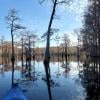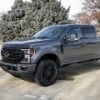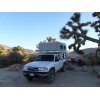I think I'm going to try yet another approach to insulating the pop-up soft-sides of my FWC Hawk -- my third approach in as many winters.
Two years ago I bought closed-cell foam (polyethylene) and cut it to length/width to fit the sides. I used adhesive strips of Velcro to attach it to the stock strip of loops at the top of the wall. This worked OK, but there were a couple of problems/drawbacks to this approach:
- The foam makes a big, bulky roll(s) when removed from the wall.
- Because the foam is relatively rigid, if the wind blows and causes the soft-side to flex then the foam buckles and pulls away from the bottom of the wall -- it doesn't seal well -- and cold air spills down/out from behind the foam. I guess I could establish another set of Velcro strips along the bottom of the foam, and I'd have to attach Velcro to the top of the hard-side to mate....
- Adhesive Velcro doesn't stick well to polyethylene (almost nothing does), and the strips were peeling off the foam on my first trip. I guess I could sew/staple the Velcro to the foam...
I considered using fleece before I tried Reflectix, but I figured I'd have to use really thick/heavy fleece to equal the insulation/R-value of the closed-cell foam or the Reflectix. But now that I understand that the commercial Arctic-Pack works by trapping a simple, unbaffled layer of air against the soft-side and seems to have little/no insulation of its own I see that even standard/light-weight fleece should work.
And since fleece has intrinsic insulating value -- as well as the ability to trap air between it and the soft-side -- it might be better than the Arctic Pack approach.
Upsides vs my two previous approaches:
- Soft/flexible so it can be folded/stuffed into any shape for storage
- Soft/flexible so it can flex when/if the soft-side does and maintain a better seal against the top of the hard-side...though, a set of Velcro across the bottom would still be a good thing.
- It's porous, so it could absorb stuff (water, grease, dirt). But it's machine-washable, and water dries fast from fleece.
- I'll have to sew or staple Velcro strips to the fleece since adhesive surely won't work.
Has anyone tried fleece as soft-side insulation?
















